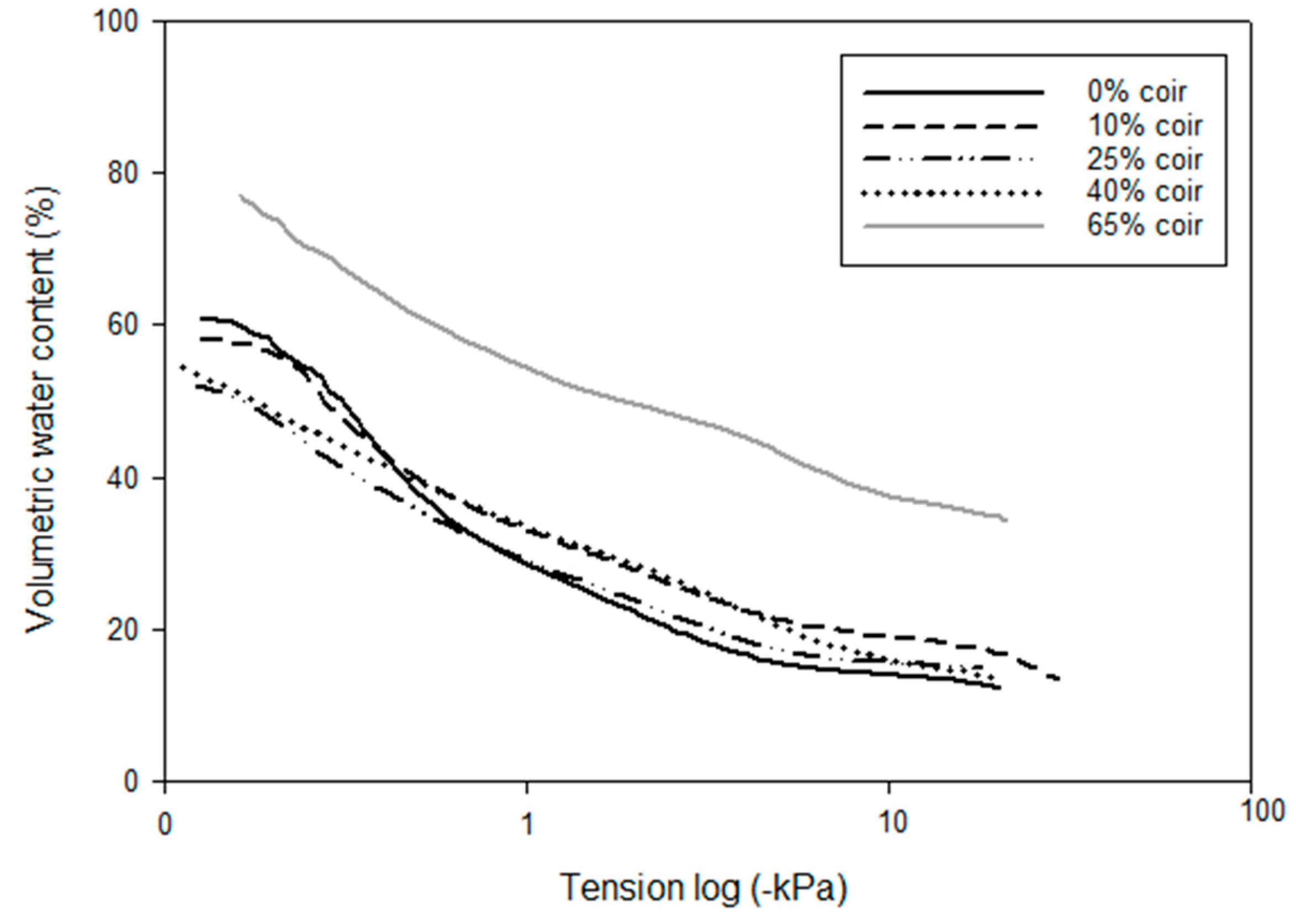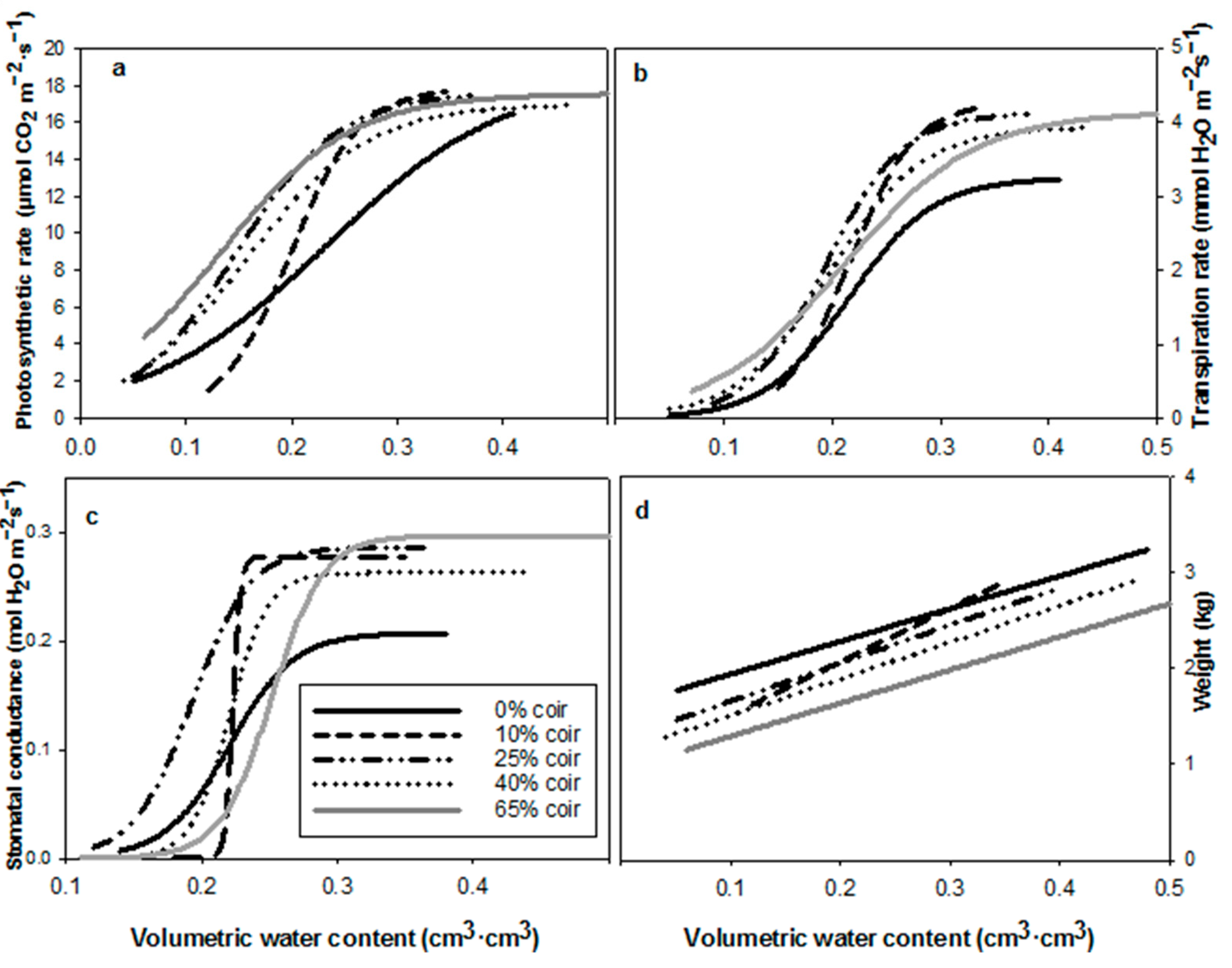Optimizing Substrate Available Water and Coir Amendment Rate in Pine Bark Substrates
Abstract
1. Introduction
2. Materials and Methods
3. Results and Discussion
3.1. Physical Properties
3.2. Plant Gas Exchange Parameters
4. Conclusions
Author Contributions
Funding
Acknowledgments
Conflicts of Interest
References
- Food and Agricultural Organization of the United Nations, Coping with Water Scarcity. 2007. Available online: http://www.fao.org/nr/water/docs/escarcity.pdf (accessed on 26 February 2013).
- Kenny, J.F.; Barber, N.L.; Hutson, S.S.; Linsey, K.S.; Lovelace, J.K.; Maupin, M.A. Estimated use of water in the United States in 2005. U.S. Geological Survey, Reston, VA. Circular 2009, 1344, 52. [Google Scholar]
- Beeson, R.C. Modeling actual evapotranspiration of Viburnum odoratissimum during production from rooted cuttings to market size plants in 11.4-L containers. Hortic. Sci. 2010, 45, 1260–1264. [Google Scholar] [CrossRef]
- Bethke, J.A.; Cloyd, R.A. Pesticide use in ornamental production: What are the benefits? Pest Manag. Sci. 2009, 65, 345–350. [Google Scholar] [CrossRef] [PubMed]
- Wilson, P.C.; Albano, J.P. Impact of fertigation versus controlled-release fertilizer formulations on nitrate concentrations in nursery drainage water. Hortic. Technol. 2011, 21, 176–180. [Google Scholar] [CrossRef]
- Fulcher, A.; Fernandez, T. Sustainable nursery irrigation management series: Part, I. Water use in nursery production. Univ. Tenn. Bul. 2013, W287. [Google Scholar]
- Caron, J.; Elrick, D.E.; Beeson, R.; Boudreau, J. Defining critical capillary rise properties for growing media in nurseries. Soil Sci. Soc. Am. J. 2005, 69, 794–806. [Google Scholar] [CrossRef]
- Beeson, R.C., Jr.; Arnold, M.A.; Bilderback, T.E.; Bolusky, B.; Chandler, S.; Gramling, H.M.; Lea-Cox, J.D.; Harris, J.R.; Klinger, P.J.; Mathers, H.M.; et al. Strategic vision of container nursery irrigation in the next ten years. J. Environ. Hortic. 2004, 22, 113–115. [Google Scholar]
- Majsztrik, J.C.; Fernandez, R.T.; Fisher, P.R.; Hitchcock, D.R.; Lea-Cox, J.; Owen, J.S.; Oki, L.R.; White, S.A. Water use and treatment in container-grown specialty crop production: A review. Water Air Soil Pollut. 2017, 228, 151. [Google Scholar] [CrossRef]
- State of Michigan. Public Act 148, 2003. Available online: http://www.legislature.mi.gov/documents/2003-2004/publicact/htm/2003-PA-0148.htm (accessed on 22 January 2020).
- Fulcher, A.; LeBude, A.V.; Owen, J.S.; White, S.A.; Beeson, R.C. The next ten years: Strategic vision of water resources for nursery producers. Hortic. Technol. 2016, 26, 121–132. [Google Scholar] [CrossRef]
- Barrett, G.E.; Alexander, P.D.; Robinson, J.S.; Bragg, N.C. Achieving environmentally sustainable growing media for soilless plant cultivation systems–A review. Sci. Hortic. 2016, 212, 220–234. [Google Scholar] [CrossRef]
- Fields, J.S.; Owen, J.S.; Scoggins, H.L. The influence of substrate hydraulic conductivity on plant water status of an ornamental container crop grown in suboptimal substrate water potentials. Hortic. Sci. 2017, 52, 1419–1428. [Google Scholar] [CrossRef]
- Hoskins, T.C.; Owen, J.S.; Niemiera, A.X. Water movement through a pine-bark substrate during irrigation. Hortic. Sci. 2014, 49, 1432–1436. [Google Scholar] [CrossRef]
- Altland, J.E.; Owen, J.S.; Jackson, B.E.; Fields, J.S. Physical and hydraulic properties of commercial pine-bark substrate products used in production of containerized crops. Hortic. Sci. 2018, 53, 1883–1890. [Google Scholar] [CrossRef]
- Basiri Jahromi, N.; Walker, F.; Fulcher, A.; Altland, J.; Wright, W.C. Growth response, mineral nutrition, and water utilization of container-grown woody ornamentals grown in biochar-amended pine bark. Hortic. Sci. 2018, 53, 347–353. [Google Scholar]
- Basiri Jahromi, N. Improving Water Use Efficiency of Containerized Crops Using Biochar and Precision Irrigation Scheduling. Ph.D. Thesis, University of Tennessee, Knoxville, TN, USA, 2019. [Google Scholar]
- Basiri Jahromi, N.; Walker, F.; Fulcher, A.; Altland, J. Photosynthesis, growth, and water use of Hydrangea paniculata ‘Silver Dollar’ produced with different irrigation schedules and biochar substrate amendment. Hortic. Sci. 2017, 52, S273–S274. [Google Scholar]
- Basiri Jahromi, N.; Walker, F.; Fulcher, A. What is biochar and how different biochars can improve your crops. UT Ext. 2019, W829. [Google Scholar]
- Arenas, M.; Vavrina, C.S.; Cornell, J.A.; Hanlon, E.A.; Hochmuth, G.J. Coir as an alternative to peat in media for tomato transplant production. Hortic. Sci. 2002, 37, 309–312. [Google Scholar] [CrossRef]
- Michel, J.C. The physical properties of peat: A key factor for modern growing media. Mires Peat 2010, 6, 1–6. [Google Scholar]
- Blok, C.; Wever, G. Experience with selected physical methods to characterize the suitability of growing media for plant growth. Acta Hortic. 2008, 779, 239–249. [Google Scholar] [CrossRef]
- Hagen, E.; Fulcher, A.; Sun, X. Determining sensor orientation and depth within an 11.4 L container to estimate whole container volumetric water content. Appl. Eng. Agric. 2015, 31, 597–603. [Google Scholar]
- Hagen, E.; Nambuthiri, S.; Fulcher, A.; Geneve, R. Comparing substrate moisture-based daily water use and on-demand irrigation regimes for oakleaf hydrangea grown in two container sizes. Hortic. Sci. 2014, 179, 132–139. [Google Scholar] [CrossRef]
- Fulcher, A.; Buxton, J.W.; Geneve, R.L. Developing a physiological-based, on-demand irrigation system for container production. Hortic. Sci. 2012, 138, 221–226. [Google Scholar] [CrossRef]
- Nambuthiri, S.; Hagen, E.; Fulcher, A.; Geneve, R. Evaluating a physiological-based, on-demand irrigation system for container-grown woody plants with different water requirements. Hortic. Sci. 2017, 52, 251–257. [Google Scholar] [CrossRef]
- Basiri Jahromi, N.; Fulcher, A.; Walker, F.; Altland, J.; Wright, W.; Eash, N. Evaluating on-demand irrigation systems for container-grown woody plants grown in biochar-amended pine bark. Hortic. Sci. 2018, 53, 1891–1896. [Google Scholar]
- O’Meara, L.; Chappell, M.R.; van Iersel, M.W. Water use of Hydrangea macrophylla and Gardenia jasminoides in response to a gradually drying substrate. Hortic. Sci. 2014, 49, 493–498. [Google Scholar] [CrossRef]
- Montesano, F.F.; van Iersel, M.W.; Boari, F.; Cantore, V.; D’Amato, G.; Parente, A. Sensor-based irrigation management of soilless basil using a new smart irrigation system: Effects of set-point on plant physiological responses and crop performance. Agric. Water Manag. 2018, 203, 20–29. [Google Scholar] [CrossRef]
- Fonteno, W.C.; Harden, C.T. North Carolina state university horticultural substrates lab manual. N. C. State Univ. Raleigh NC 2010, 49, 827–832. [Google Scholar]
- Fulcher, A.; Fessler, L.; Piestch, G.; Wright, W. Improving plant available water during container production through leaching fraction-based irrigation scheduling and coir substrate amendment. Unpublished work. 2020. [Google Scholar]
- Bilderback, T.; Boyer, C.; Chappell, M.; Fain, G.; Fare, D.; Gilliam, C.; Jackson, B.E.; Lea-Cox, J.; LeBude, A.V.; Niemiera, A.; et al. Best Management Practices: Guide for Producing Nursery Crops, 3rd ed.; Southern Nursery Association: Acworth, GA, USA, 2013. [Google Scholar]
- Arguedas-Rodriguez, F.R. Calibrating Capacitance Sensors to Estimate Water Content, Matric Potential, and Electrical Conductivity in Soilless Substrates. Master’s Thesis, University of Maryland, Baltimore, MD, USA, 2009; p. 118. [Google Scholar]
- de Boodt, M.; Verdonck, O. The physical properties of substrates in horticulture. Acta Hortic. 1972, 26, 37–44. [Google Scholar] [CrossRef]
- Fields, J.S.; Owen, J.S.; Altland, J.E.; van Iersel, M.W.; Jackson, B.E. Soilless substrate hydrology can be engineered to influence plant water status for an ornamental containerized crop grown within optimal water potentials. J. Amer. Soc. Hortic. Sci. 2018, 143, 268–281. [Google Scholar] [CrossRef]
- Fulcher, A.; Geneve, R.L. Relationship between photosynthesis and substrate moisture for container-grown Hibiscus and Cornus. Acta Hortic. 2011, 922, 183–186. [Google Scholar] [CrossRef]
- Fernández, J.E. Plant-based methods for irrigation scheduling of woody crops. Horticulturae 2017, 3, 35. [Google Scholar] [CrossRef]
- Belayneh, B.E.; Lea-Cox, J.D.; Lichtenberg, E. Costs and benefits of implementing sensor-controlled irrigation in a commercial pot-in-pot container nursery. Hortic. Technol. 2013, 23, 760–769. [Google Scholar] [CrossRef]
- San Diego County Water Authority. Water Authority’s Proposed 2019 Rate Increases Smallest in Years. Available online: https://www.sdcwa.org/water-authoritys-proposed-2019-rate-increases-smallest-years. (accessed on 20 January 2018).
- Advanced Energy Economy. Bringing California’s Water-Energy System Into the 21st Century Addressing Greenhouse Gas Emissions Through Technology. Available online: https://info.aee.net/bringing-californias-water-energy-system-into-the-21st-century (accessed on 20 January 2020).
- Lichtenberg, E.; Majsztrik, J.; Saavoss, M. Profitability of sensor-based irrigation in greenhouse and nursery crops. Hortic. Technol. 2013, 23, 770–774. [Google Scholar] [CrossRef]
- Chappell, M.; Dove, S.K.; van Iersal, M.W.; Thomas, P.A.; Ruter, J. Implementation of wireless sensor networks for irrigation control in three container nurseries. HortTechnology 2013, 23, 747–753. [Google Scholar] [CrossRef]
- Warsaw, A.L.; Fernandez, R.T.; Cregg, B.M.; Andresen, J.A. Water conservation, growth, and water use efficiency of container–grown woody ornamentals irrigated based on daily water use. Hortic. Sci. 2009, 44, 1308–1318. [Google Scholar] [CrossRef]
- Daniels, A.B.; Barnard, D.M.; Chapman, P.L.; Bauerle, W.L. Optimizing substrate moisture measurements in containerized nurseries. Hortic. Sci. 2012, 47, 98–104. [Google Scholar] [CrossRef]


| Coir Rate (%) | Total Porosity (%) | Air Space (%) | Container Capacity (%) | Bulk Density (g/cm3) |
|---|---|---|---|---|
| 0 | 69 ± 3 | 30 ± 0 a y | 39 ± 0.03 c | 0.18 ± 0 a |
| 10 | 79 ± 2 | 35 ± 0.01 a | 44 ± 0.01 bc | 0.18 ± 0 a |
| 25 | 77 ± 3 | 29 ± 0.04 a | 48 ± 0.02 b | 0.16 ± 0 b |
| 40 | 77 ± 3 | 29 ± 0.02 a | 48 ± 0.02 b | 0.14 ± 0.01 c |
| 65 | 81 ± 3 | 21 ± 0.03 b | 59 ± 0.02 a | 0.11 ± 0 d |
| P-value | 0.0600 | 0.0300 | 0.0006 | <0.0001 |
| Photosynthetic Rate = a/(1 + exp (−(VWC − x0)/b)) | ||||
| Treatment | a | x0 | b | r2 |
| 0% coir | 18.59 | 0.23 | 0.09 | 0.57 |
| 10% coir | 17.85 | 0.23 | 0.03 | 0.68 |
| 25% coir | 17.64 | 0.15 | 0.05 | 0.60 |
| 40% coir | 17.00 | 0.16 | 0.06 | 0.60 |
| 65% coir | 17.56 | 0.13 | 0.06 | 0.64 |
| Transpiration Rate = a/(1 + exp (−(VWC − x0)/b)) | ||||
| Treatment | a | x0 | b | r2 |
| 0% coir | 3.25 | 0.21 | 0.04 | 0.47 |
| 10% coir | 4.27 | 0.22 | 0.03 | 0.68 |
| 25% coir | 4.12 | 0.19 | 0.04 | 0.65 |
| 40% coir | 3.94 | 0.20 | 0.04 | 0.46 |
| 65% coir | 4.14 | 0.21 | 0.06 | 0.63 |
| Stomatal Conductance = a/(1 + exp (−(VWC − x0)/b)) | ||||
| Treatment | a | x0 | b | r2 |
| 0% coir | 0.21 | 0.22 | 0.02 | 0.51 |
| 10% coir | 0.28 | 0.22 | 0.00 | 0.42 |
| 25% coir | 0.29 | 0.19 | 0.02 | 0.54 |
| 40% coir | 0.26 | 0.22 | 0.01 | 0.45 |
| 65% coir | 0.30 | 0.50 | 0.02 | 0.55 |
| Weight = y0 + a × VWC | ||||
| Treatment | y0 | a | r2 | |
| 0% coir | 1.60 | 3.40 | 0.75 | |
| 10% coir | 0.96 | 5.55 | 0.76 | |
| 25% coir | 1.26 | 3.94 | 0.90 | |
| 40% coir | 1.13 | 3.81 | 0.89 | |
| 65% coir | 0.95 | 3.45 | 0.87 | |
© 2020 by the authors. Licensee MDPI, Basel, Switzerland. This article is an open access article distributed under the terms and conditions of the Creative Commons Attribution (CC BY) license (http://creativecommons.org/licenses/by/4.0/).
Share and Cite
Basiri Jahromi, N.; Fulcher, A.; Walker, F.; Altland, J. Optimizing Substrate Available Water and Coir Amendment Rate in Pine Bark Substrates. Water 2020, 12, 362. https://doi.org/10.3390/w12020362
Basiri Jahromi N, Fulcher A, Walker F, Altland J. Optimizing Substrate Available Water and Coir Amendment Rate in Pine Bark Substrates. Water. 2020; 12(2):362. https://doi.org/10.3390/w12020362
Chicago/Turabian StyleBasiri Jahromi, Nastaran, Amy Fulcher, Forbes Walker, and James Altland. 2020. "Optimizing Substrate Available Water and Coir Amendment Rate in Pine Bark Substrates" Water 12, no. 2: 362. https://doi.org/10.3390/w12020362
APA StyleBasiri Jahromi, N., Fulcher, A., Walker, F., & Altland, J. (2020). Optimizing Substrate Available Water and Coir Amendment Rate in Pine Bark Substrates. Water, 12(2), 362. https://doi.org/10.3390/w12020362






